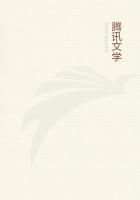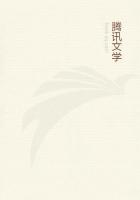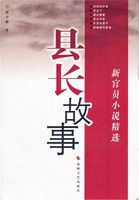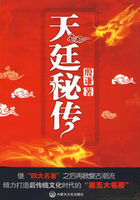As the frame pieces are generally about 1 1/2 inch in diameter, the tongue and the groove into which the tongue fits must be correspondingly small. Begin by sawing into one side of one of the frame pieces about 4inches back from the end. Make the cut about 1/2 inch deep. Then turn the piece over and duplicate the cut.
Next saw down from the end to these cuts. When the sawed-out parts are removed you will have a "tongue"in the end of the frame timber 4 inches long and 1/2 inch thick. The next move is to saw out a 5/8-inch groove in the end of the frame piece which is to be joined. You will have to use a small chisel to remove the 5/8-inch bit.
This will leave a groove into which the tongue will fit easily.
Joining the Two Pieces.
Take a thin metal sleeve--this is merely a hollow tube of aluminum or brass open at each end--8 inches long, and slip it over either the tongued or grooved end of one of the frame timbers. It is well to have the sleeve fit snugly, and this may necessitate a sand-papering of the frame pieces so the sleeve will slip on.
Push the sleeve well back out of the way. Cover the tongue thoroughly with glue, and also put some on the inside of the groove. Use plenty of glue. Now press the tongue into the groove, and keep the ends firmly together until the glue is thoroughly dried. Rub off the joint lightly with sand-paper to remove any of the glue which may have oozed out, and slip the sleeve into place over the joint. Tack the sleeve in position with small copper tacks, and you will have an ideal splice.
The same operation is to be repeated on each of the four frame pieces. Two 20-foot pieces joined in this way will give a substantial frame, but when suitable timber of this kind can not be had, three pieces, each 6feet 11 inches long, may be used. This would give 20feet 9 inches, of which 8 inches will be taken up in the two joints, leaving the frame 20 feet 1 inch long.
Installation of Motor.
Next comes the installation of the motor. The kinds and efficiency of the various types are described in the following chapter (IX). All we are interested in at this point is the manner of installation. This varies according to the personal ideas of the aviator. Thus one man puts his motor in the front of his machine, another places it in the center, and still another finds the rear of the frame the best. All get good results, the comparative advantages of which it is difficult to estimate. Where one man, as already explained, flies faster than another, the one beaten from the speed standpoint has an advantage in the matter of carrying weight, etc.
The ideas of various well-known aviators as to the correct placing of motors may be had from the following:
Wrights--In rear of machine and to one side.
Curtiss--Well to rear, about midway between upper and lower planes.
Raich--In rear, above the center.
Brauner-Smith--In exact center of machine.
Van Anden--In center.
Herring-Burgess--Directly behind operator.
Voisin--In rear, and on lower plane.
Bleriot--In front.
R. E. P.--In front.
The One Chief Object.
An even distribution of the load so as to assist in maintaining the equilibrium of the machine, should be the one chief object in deciding upon the location of the motor. It matters little what particular spot is selected so long as the weight does not tend to overbalance the machine, or to "throw it off an even keel." It is just like loading a vessel, an operation in which the expert seeks to so distribute the weight of the cargo as to keep the vessel in a perfectly upright position, and prevent a "list" or leaning to one side. The more evenly the cargo is distributed the more perfect will be the equilibrium of the vessel and the better it can be handled. Sometimes, when not properly stowed, the cargo shifts, and this at once affects the position of the craft. When a ship "lists" to starboard or port a preponderating weight of the cargo has shifted sideways; if bow or stern is unduly depressed it is a sure indication that the cargo has shifted accordingly. In either event the handling of the craft becomes not only difficult, but extremely hazardous.
Exactly the same conditions prevail in the handling of a flying machine.
Shape of Machine a Factor.
In placing the motor you must be governed largely by the shape and construction of the flying machine frame.
If the bulk of the weight of the machine and auxiliaries is toward the rear, then the natural location for the motor will be well to the front so as to counterbalance the excess in rear weight. In the same way if the preponderance of the weight is forward, then the motor should be placed back of the center.
As the propeller blade is really an integral part of the motor, the latter being useless without it, its placing naturally depends upon the location selected for the motor.
Rudders and Auxiliary Planes.
Here again there is great diversity of opinion among aviators as to size, location and form. The striking difference of ideas in this respect is well illustrated in the choice made by prominent makers as follows:
Voisin--horizontal rudder, with two wing-like planes, in front; box-like longitudinal stability plane in rear, inside of which is a vertical rudder.
Wright--large biplane horizontal rudder in front at considerable distance--about 10 feet--from the main planes; vertical biplane rudder in rear; ends of upper and lower main planes made flexible so they may be moved.
Curtiss--horizontal biplane rudder, with vertical damping plane between the rudder planes about 10 feet in front of main planes; vertical rudder in rear; stabilizing planes at each end of upper main plane.
Bleriot--V-shaped stabilizing fin, projecting from rear of plane, with broad end outward; to the broad end of this fin is hinged a vertical rudder; horizontal biplane rudder, also in rear, under the fin.



